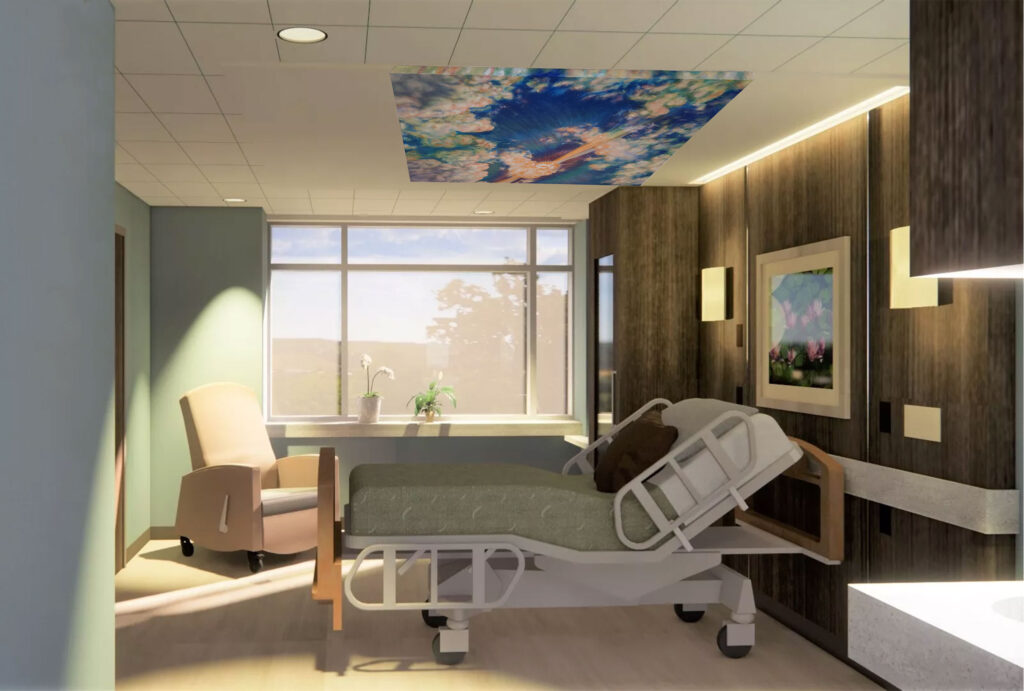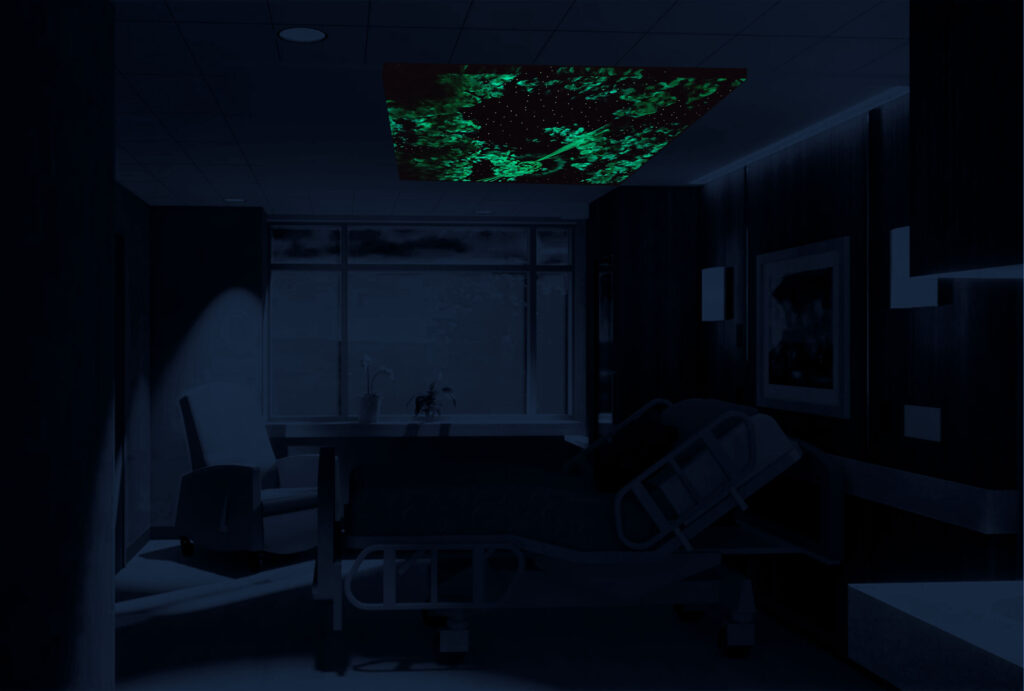Looking Up Wellness
Therapeutic Art For Patients
Looking Up Wellness is a public service for local hospitals, long term care, hospices, and at home patients. It provides therapeutic wellness paintings that mount over patient beds, and are created by a licensed Art Therapist. The paintings emulate skylights, charge by light and glow in the dark, providing the patient with 24/7 aid.
Research shows that patients who have art to view heal faster, need less pain medication, feel safer, and experience less anxiety and depression. When a patient feels safe, the nervous system is calm, and allows the body to focus less on survival and more on healing.
Energetic studies of artwork supports that a hand painted work provides an “energetic companion” for the patient, and reminds the patient they are not alone. The law of conservation of energy applies here; energy cannot be created or destroyed, only transferred. Research confirms that the intention of serenity and love that the artist holds is transferred and delivered to whomever views the work. A digital printed work would not hold this same energy or provide the same benefit to the patient.
Additionally, the wellness paintings offer and opportunity for family/friends to bond with the patient, serving as a talking point and shared experience. The painting can stand as a representation for the patient’s triumph in recovery and healing. If the painting is above a bed in hospice, it can also be an image the family can cherish, standing as a memory for their loved one.
The presence of artwork in hospitals also improves staff morale, which can intern improve the quality of care in any hospital, long term care, or recovery setting. Studies on the brain while looking at artwork how that viewing art gives the same pleasure as being in love. Therapeutic wellness paintings provide a sense of safety, love, and companionship for a patient which aids in healing and/or comfort during the end-of-life process. More in depth research is written below and can also be viewed in the research video below.

Charges by Light!
(Any Sunlight or indoor light)

Glows at Night
(Glow lasts the entire night)
How and Why it Helps
- Patients who have art in their hospital rooms recover faster, need less pain medication, experience less anxiety and depression, feel more comforted, and perceive their stay more positively as a higher quality of care
- Art allows patients to have “positive distraction” from their condition either bringing one back to the present moment or allowing them to daydream and get “lost” in the image.
- Art of open spaces in nature with no threatening weather or animals are most soothing to us from a biological perspective; they feel safe. Safety allows our physiology to work less on survival and more on healing and experiencing a calm mental state.
- Viewing art can give one the same feeling of love due to the release of dopamine.
- Other research suggests that hand painted art can connect with the viewer energetically and allows them to feel safer, like having an energetic friend; they aren’t alone. The energy from the artist’s hand is carried over into the painting creating a unique aura (energy cannot be created or destroyed, only transferred).
- The presence of hand painted artwork can expand one’s consciousness through “embodied cognition.” This can potentially occur when the viewer fires the same neurons as the artist did when they created it, thus making new neural pathways and stimulating a state of inspiration.
- The presence of artwork strengthens bonding, often serving as a talking point for conversation. Each piece becomes a shared experience for everyone who visits or is in the room with the patient/client.
- The artwork holds sentimental value and can be a symbol of the loved one’s experience (hospice) or for the personal accomplishment of strength of the patient/client who has recovered.
- If a loved one has passed, the wellness painting can aid in the grieving process, standing as a shared experience and memory of their last days.
- Artwork improves staff morale aiding in a more effective environment for everyone.
- Care facilities increase their attractiveness to potential patients and stand out from the rest.
Who Benefits
Any patient in a clinical or home setting who is experiencing extensive hours in bed, or undergoing procedure while on their backs (physical or therapeutic). Patients in long or short term recovery (from physical/mental struggles, or addictions), senior living, or hospice care.
Senior Living Care
Hospice and Palliative Care
Rehabilitation Centers
Mental Health/Psychiatric Hospitals
Medical Hospitals including Obstetrics and Gynecology/ Labor and Delivery/Intensive Care Units
Family Planning Clinics
Psychedelic Assisted Therapy Offices
Acupuncture Facilities
Dentist Offices
Patient Homes
What History Tells Us
- Art incorporated in hospital settings is not new, and dates to the Middle Ages. El Greco, Van Gogh, and Rembrandt are among some of the artists who were commissioned for this purpose. Often these images addressed the mind and spirit of the patients.
- During the Great Depression, murals in hospitals were commissioned by the US government.
- During the recent pandemic, murals and art in hospitals have also been increased. Humans are craving a more comforting medical model after the fear and seriousness of the pandemic.
- Neuroaesthetics is a scientific study examining the brain while one contemplates a work of art. It involves measuring brain activity using technology like fMRI machine while subject view art. It seems our innate intelligence has supported this concept for centuries. We have known that art provides great comfort in our most vulnerable times, and now we have the technology to confirm this
- Our history supports this continued effort to provide a sense of comfort in our most vulnerable times.
Research Video
References
Beauty and the Brain: An Interview With the Father of Neuroesthetics, Semir Zeki — Part One. (2015, September 29). HuffPost. https://www.huffpost.com/entry/beauty-and-the-brain-an-i_b_8197890
Conservation of energy – New World Encyclopedia. (n.d.). Www.newworldencyclopedia.org. https://www.newworldencyclopedia.org/entry/Conservation_of_energy
https://ceasefiremagazine.co.uk/author/andrew-robinson. (2013, July 2). Walter Benjamin: Art, Aura and Authenticity. Ceasefire Magazine. https://ceasefiremagazine.co.uk/walter-benjamin-art-aura-authenticity/
Holland, K. (2023, January 9). Considering Value of Original Vs. Printed Art [Email Considering Value of Original Vs. Printed Art].
Hospital Rooms | Healing Arts. (n.d.). Www.youtube.com. Retrieved February 22, 2023, from https://www.youtube.com/watch?v=xFnTqIaDiU4
Lankston, L., Cusack, P., Fremantle, C., & Isles, C. (2010). Visual art in hospitals: case studies and review of the evidence. Journal of the Royal Society of Medicine, 103(12), 490–499. https://doi.org/10.1258/jrsm.2010.100256
Lecture 13 – Design Guidelines for Homes, Offices, Classrooms, and Hospitals. (n.d.). Www.youtube.com. Retrieved February 22, 2023, from https://www.youtube.com/watch?v=fw2TigLITN8&list=PLA2E69FC89640C272&index=13
Lecture 15 – Natural Environments and Restorative Settings. (n.d.). Www.youtube.com. Retrieved February 22, 2023, from https://www.youtube.com/watch?v=8wepK7Xt0O0&list=PLA2E69FC89640C272&index=15
Nielsen, S. L., Fich, L. B., Roessler, K. K., & Mullins, M. F. (2017). How do patients actually experience and use art in hospitals? The significance of interaction: a user-oriented experimental case study. International Journal of Qualitative Studies on Health and Well-Being, 12(1), 1267343. https://doi.org/10.1080/17482631.2016.1267343
Magsamen, S. (2019). Your Brain on Art: The Case for Neuroaesthetics. Cerebrum: The Dana Forum on Brain Science, 2019. https://www.ncbi.nlm.nih.gov/pmc/articles/PMC7075503/
Miller, M. F., & Kravits, K. (2013). Nurses’ Use of Art in Hospice Settings. Journal of Hospice & Palliative Nursing, 15(1), 5–10. https://doi.org/10.1097/njh.0b013e31827ce345
Paras, K. (2023, January 10). Art Created by Human Hands Vs. Mechanical Means [Email Art Created by Human Hands Vs. Mechanical Means].
Phillips, R. (2015, May 13). Art Enhances Brain Function and Well-Being. Healing-Power-of-Art.org. https://www.healing-power-of-art.org/art-and-the-brain/
Rollins, J. (2021). “Purpose-built” Art in Hospitals. Emerald Group Publishing.
Sima, R. (2020, May 14). How Art Brings Humanity and Healing to the Patient’s Bedside. International Arts + Mind Lab: The Center for Applied Neuroaesthetics. https://www.artsandmindlab.org/how-art-brings-humanity-and-healing-to-the-patients-bedside/
The Great Reflection Summit. (n.d.). Jackson, Laura Lynne. “Accessing The Other Side.” Www.greatreflectionsummit.com. Retrieved February 20, 2024, from https://www.greatreflectionsummit.com/products/great-reflectionsummit/categories/2153098815/posts/2175194441
WATCH: Looking At Art Gives The Same Pleasure As Being In Love. (2011, May 18). HuffPost. https://www.huffpost.com/entry/falling-in-love-with-art_n_861812
In-text citation: (K. Holland, personal communication, January 9, 2023)
(K. Paras, personal communication, January 10, 2023)
